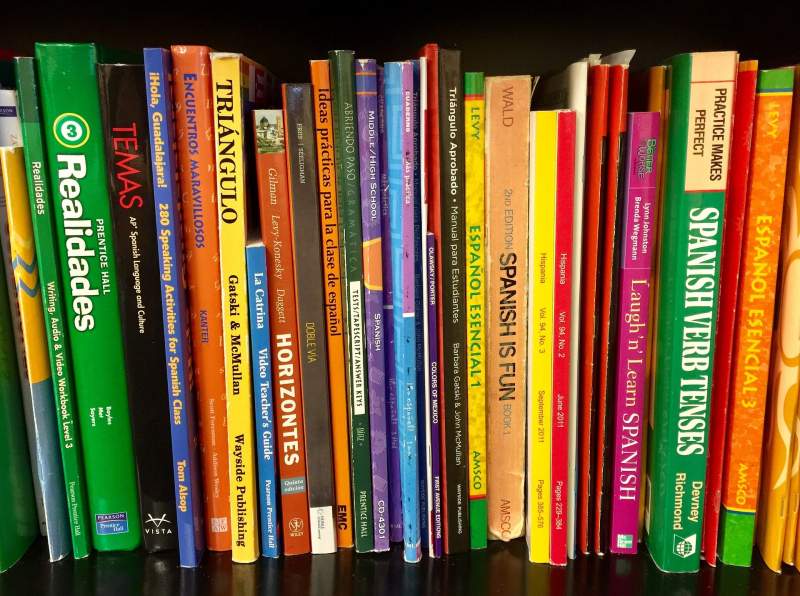Is Spanish hard to learn? If you're asking this question then you're probably considering learning Spanish yourself.
Whatever the reason you have for learning Spanish, it's a wonderful language to learn.
In fact, judged by number of native speakers, Spanish is the second most-spoken language in the world.
But before you can chat with native speakers over tapas or enjoy award-winning films like El labertino del fauno (Pan's Labyrinth) without subtitles, you're probably wondering… Is Spanish hard to learn in the first place?
In this article, I'm going to answer that question. I'll show you:
- What makes Spanish an easy language to learn
- The potential pitfalls for Spanish language learners
- The best advice I have for anyone starting to learn Spanish for the first time
By the end of the post, you'll be motivated to start learning Spanish and ready for your learning journey to begin.
Pro Tip
Anyway, back to the question at hand: Is Spanish hard to learn?
If you prefer watching videos, check out the video version at the top of this page.
Otherwise, keep scrolling to read the post and discover, once and for all the answer to the question – is Spanish hard to learn?
Table of Contents
What Makes Spanish An Easy Language To Learn

The U.S. Department of State maintains a ranking of languages based on how much time they typically take an average native English speaker to learn to a proficient level. So is Spanish hard to learn for English speakers?
The first tier of languages, classified as the easiest for English speakers to learn, contains nine languages—including Spanish.
(If you've read my analysis on whether French is hard to learn, this probably sounds familiar. French is in the first tier of languages as well.)
Spanish is considered an easy language to learn because it shares so many characteristics with English.
Similarities To English That Simplify Learning Spanish
For starters, there are three things Spanish and English have in common that make Spanish an easy language to learn:
- The alphabet
- Pluralisation
- Similar vocabulary
Let's take a look at each one of these in turn.
#1: The Spanish Alphabet

What do I mean the alphabet? Doesn't Spanish have unique letters like ñ that we don't use in English?
English and Spanish both use what is known as the Roman or Latin alphabet, as do most other European languages (such as French, Italian, and German).
Unless you've tried to learn a language that uses something other than the Latin alphabet (such as Japanese, Russian, Arabic, or Mandarin Chinese), you might not have considered what an advantage it is to learn a language that shares the same basic alphabet with English.
When people ask me “how hard is Spanish to learn for English speakers?”, this is always one of the key things I point to which demonstrates that it doesn't have to be intimidating.
As an added bonus, the letters in the alphabet use many of the same sounds as in English.
With a few exceptions, most of the consonants are pronounced almost the same way in English and Spanish.
Once you learn how to pronounce g, h, j, ll, x, and z in Spanish, you can generally make a good guess at how to pronounce most Spanish words.
There are some subtle pronunciation differences with letters like t, b, and d, but you can work on those later in your Spanish-learning journey.
#2: Pluralisation

Spanish words are pluralised in the same way as in English: by adding an –s or –es to the ends of words.
One amiga becomes two amigas when another friend arrives at the party.
When you order drinks for the table, you want multiple bebidas.
This might not seem like a big advantage to learning Spanish until you realise how many languages do not pluralise with a simple –s:
- In Dutch, plurals are often formed with –en
- In Italian, plural words either end in –i or –e, depending on whether they're feminine or masculine
- Japanese doesn't have a separate plural form at all!
When you're first starting out with Spanish, pluralisation is one less thing for you to remember.
#3: Similar Vocabulary

Because many English words share the same Latin root as their Spanish counterparts, you probably already know more Spanish words than you think.
In language study, words that are identical (or nearly so) in two languages are known as “cognates.” And English and Spanish share thousands of them!
The pronunciations vary slightly from English to Spanish. But the words are often spelled exactly the same way! So you immediately get lots of free vocabulary to help you communicate faster in your new language because you'll already know the meanings of so many words.
Take a look at this list of Spanish words and see how many you recognise without ever cracking open a dictionary:
- artificial
- auto
- básico
- celebración
- central
- club
- delicioso
- doctor
- error
- exterior
- fantástico
- ficción
- final
- hospital
- hotel
- idea
- individual
- irregular
- melon
- natural
- particular
- perfecto
- similar
- superior
- televisión
- vertical
- vocabulario
One word of warning about cognates…
You'll want to learn the most common false cognates—words that look like English words but actually mean something else entirely—to avoid a potentially embarrassing misunderstanding.
More often than not, however, the shared vocabulary between the languages will help you learn Spanish faster and easier.
Unique Characteristics Of Spanish That Make It Easy
By now you're probably realising that the answer to the question “Is Spanish hard to learn?” is… not that hard.
Two aspects of the Spanish language that make it easy to learn are:
- The fact that it's spoken all over the world
- The consistency of both Spanish spelling and Spanish pronunciation
Let's take a look at how both of these features will help you out as a new Spanish learner.
Spanish Is Spoken All Over The World
Spanish is the second most common language in the world by number of native speakers.
That means, no matter where you live in the world, you can probably find a local hispanohablante (Spanish speaker) to practice without having to travel abroad.
It also means that Spanish books, Spanish tutors, news, and entertainment are easier to find than for most other languages.
Many video streams come with Spanish subtitle options or alternate Spanish broadcasts thanks to the large communities of Spanish speakers around the world. This has a big impact on how hard it is to learn Spanish… or how easy! If you're learning Spanish, it's made a lot easier by the sheer volume of native speakers and interesting content, something that is not always available for endangered languages.
Consistent Spanish Spelling & Pronunciation

One big advantage to learning Spanish is that Spanish is pronounced almost exactly the same as it is written.
Once you learn how to pronounce each letter in the Spanish alphabet, you'll be able to correctly say just about every word in the Spanish language if you can see it written out.
You may not have a perfect command of the language right away, and regional pronunciations will differ. But compared to other languages, pronouncing and reading Spanish is fairly simple once you master the basics.
Is Spanish hard to learn in terms of pronunciation and spelling? Nope, not really!
If you want to learn more about Spanish pronunciation specifics, check out some these other articles I've written on the topic:
- The Trickiest Aspects Of Spanish Spelling
- How To Pronounce the Spanish B/V sounds With Confidence
- How The Spanish LL Is Pronounced Around The World
So, now you know about just some of the many reasons why learning Spanish isn't all that difficult.
But even with all of its advantages, there are a few parts of learning Spanish that can be difficult when you're just getting started. Let's take a look at them…

Potential Pitfalls That Make Spanish Hard To Learn
Do you know any other languages? If yes, have you ever studied any other Romance languages?
How easy or challenging learning Spanish is for you to learn will depend on your previous language experience.
Some common difficulties you might encounter as an English speaker when you learn Spanish are:
- Understanding Spanish verb conjugation patterns
- Getting used to Spanish word order
- Mastering tricky Spanish grammar topics such as the different Spanish past tenses
So let's consider a couple of these pitfalls now, so you know what to expect!
Spanish Verb Conjugation Patterns

Verb conjugation is the variation of verbs based on the person doing an action/the time an action happens.
Some people don't believe me when I answer “No” to the question “Is Spanish hard to learn?” and verb conjugation is normally one of the big reasons why.
In English it's relatively simple.
Let's use the verb “to eat” as an example in the simple present and past tense:
- I eat (present); I ate (past)
- You eat (present); You ate (past)
- She eats (present); She ate (past)
- We eat (present); We ate (past)
- You (pl.) eat (present); You (pl.) ate (past)
- They eat (present); They ate (past)
No matter who's doing the eating, there are only two verb conjugations in the present tense: “eat” and “eats”.
The past tense is even simpler! All five sentences use the same form of the verb: “ate”.
In Spanish, the conjugation of verbs is much more varied. We'll take a look at the simple present and past tense with the Spanish verb hablar (to talk).
- Yo hablo (present); Yo hablé (past)
- Tú hablas (present); Tú hablaste (past)
- Ella habla (present); Ella habló (past)
- Nosotros hablamos (present); Nosotros hablamos (past)
- Vosotros habláis (present); Vosotros hablasteis (past)
- Uds. hablan (present); Uds. hablaron (past)
As you can see, the verb ending changes with each subject. That's a lot more endings to memorise than in English!
The good news is that, even though conjugation charts can seem daunting at first, most Spanish verbs follow the same basic pattern.
Once you learn the rules for conjugating –ar, –er, and –ir verbs, you'll be able to apply those same principals to every new verb you learn.
Is Spanish Hard To Learn? Spanish Word Order

The good news is that Spanish word actually isn't that difficult. You'll get used to it pretty fast!
But that are a couple of key pitfalls for learners. Things that differ from English in a few significant ways.
The most obvious difference between English and Spanish word order is where adjectives (describing words like “tall” or “black”) fall in relation to the nouns (names of people, objects or concepts like “dog”, “sister”) they describe.
Take a look at the following examples:
- “I see a black dog” → Veo un perro negro.
- “My older sister is very tall”→ Mi hermana mayor es muy alta.
These and other differences in sentence order can be confusing for English speakers just starting to learn Spanish.
But you won't have to be confused for long. Spanish word order is pretty intuitive and if you read and listen to lots of Spanish as a beginner, word order will soon become second nature.
My Advice For Learning Spanish

You might read this article and decide Spanish will be easy to learn. Or you might get to this point and think it sounds incredibly challenging.
No two language learners will have the same experience with Spanish…or any other language! There is no perfect answer to the question “Is Spanish Hard to Learn?” because it depends on so many different factors that are individual to each learner.
In the end, your passion and motivation will have a huge impact on how easy (or hard) you find a language to learn.
If you're truly motivated you'll be able to overcome any hurdles you face along the way.
The best way to get started is start immersing yourself in the language from the very beginning. Make it fun! Spend lots of time reading and listening to interesting Spanish material that's been designed for beginners.
This allows you to learn naturally, stay motivated and see some progress without spend months with your head in a dusty old grammar book!
To help you out, I've created an exciting Spanish story – El Hombre Del Sombrero (The Man In The Hat).
The story is perfect for beginners. I've written so that you can start it now, even if you've never learnt a word of Spanish before.
And if forms the basis for my Spanish beginner course that teaches you Spanish from the ground up through the power of story. You can find out more information about it here.
If you're a complete beginner, this story allows you to start reading and understanding Spanish from Day 1.
Or if you've been learning Spanish for a little while, it's a great story to help you brush up on all of the Spanish you need to reach the intermediate level… whilst enjoying a cracking story at the same time!
Either way, just remember…
There's Nothing To Be Afraid Of
Learning any new language will be a challenge. And Spanish is no different.
Is Spanish hard to learn? It's not easy and it's not always fast, but there's nothing to be afraid of.
Spanish isn't impossibly difficult to learn. (In fact it's easier than most other foreign languages!)
My best advice for anyone setting out to learn Spanish is to figure out what it means to you. Find the motivation that will drive you all the way to fluency.
- Why do you want to learn Spanish?
- How will your life be better once you know Spanish?
Identify that motivation and use it to fuel the hard work of learning a new language. It'll take focused attention, but it'll be worth it!
Is Spanish Hard To Learn FAQs
How Long Does It Usually Take To Learn Spanish?
The time to learn Spanish varies based on factors like study intensity and prior language experience. On average, it takes about 600-750 hours of study to reach fluency. This could translate to 6-12 months of intensive study or 2-3 years of regular practice. For basic proficiency, learners typically need 3-6 months of consistent study.
For a full in depth breakdown, read our article: How Long Does It Take To Learn Spanish?
Is Spanish A Difficult Language To Learn?
Spanish is generally considered one of the easier languages for English speakers to learn. It shares many cognates with English and has a relatively straightforward pronunciation system. The Foreign Service Institute ranks it as a Category I language, estimating 24-30 weeks to reach professional working proficiency. However, mastering concepts like verb conjugations and gendered nouns can present challenges for some learners.
How hard is it to learn Spanish for English speakers? It's not easy, but it's far from impossible!
Is French Or Spanish Easier To Learn?
For English speakers, Spanish is generally considered easier to learn than French. Spanish has a more phonetic spelling system and simpler pronunciation rules. Its grammar, while challenging in some aspects, is often more straightforward than French.
However, individual aptitude and exposure can affect learning ease. Both languages share similarities with English, but Spanish typically requires less time to achieve proficiency for most learners.
Click here to discover more about the best way to learn Spanish or click here to learn more about the best way to learn French.
Is It Worth It To Learn Spanish?
Learning Spanish is highly worthwhile. It's the second most spoken language by native speakers globally, opening up communication with over 500 million people. Spanish enhances career opportunities, especially in international business and tourism.
It also provides access to rich cultures and literature across many countries. For English speakers, Spanish is relatively easy to learn, offering a good return on time invested in language acquisition.
Is Spanish hard to learn? It's not easy, but it's far from impossible either and the rewards are more than worth the effort you put in!

Olly Richards
Creator of the StoryLearning® Method
Olly Richards is a renowned polyglot and language learning expert with over 15 years of experience teaching millions through his innovative StoryLearning® method. He is the creator of StoryLearning, one of the world's largest language learning blogs with 500,000+ monthly readers.
Olly has authored 30+ language learning books and courses, including the bestselling "Short Stories" series published by Teach Yourself.
When not developing new teaching methods, Richards practices what he preaches—he speaks 8 languages fluently and continues learning new ones through his own methodology.









































